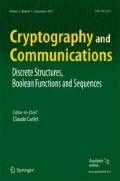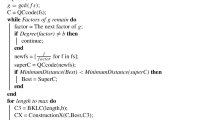Abstract
One of the most important and challenging problems in coding theory is to explicitly construct linear codes with best possible parameters. Computers are often used to search for optimal codes. However, given the large size of the search space and computational complexity of determining the minimum distance, researchers usually focus on promising classes of linear codes with rich algebraic structures. One such class of codes is quasi-twisted (QT) codes which contains cyclic, constacyclic, and quasi-cyclic (QC) codes as sub-classes. Improving and automatizing existing search algorithms for QT codes, we have been able to obtain 64 record-breaking linear codes (codes with better parameters than currently best known linear codes) over the non-prime fields \(\mathbb {F}_{4}\), \(\mathbb {F}_{8}\) and \(\mathbb {F}_{9}\). Moreover, we obtained 82 additional new codes from the standard constructions of puncturing, extending and shortening a code. Further, we have found 15 QT codes that are new among the class of QT codes.
Similar content being viewed by others
Notes
Note that when we use the standard generator for a constacyclic code, the shift constant does not show up in the first coordinate of each row vector because they are all zeros. If we use a generator of a higher degree however, then it will be necessary to include the shift constant a.
References
Grassl, M.: Code Tables: Bounds on the parameters of of codes, online, http://www.codetables.de/ (2018)
Magma computer algebra system, online, http://magma.maths.usyd.edu.au/
Vardy, A.: The intractability of computing the minimum distance of a code. IEEE Trans. Inf. Theory 43(6), 1757–1766 (1997)
Huffman, W.C., Pless, V.: Fundamentals of Error-Correcting Codes. Cambridge University Press, Cambridge (2003)
Chen, E.Z.: Six new binary quasi-cyclic codes. IEEE Trans. Inf. Theory 40(5), 1666–1667 (1994)
Gulliver, T.A., Bhargava, V.K., rate, New good: (M − 1)/p m ternary and quaternary quasi-cyclic codes. Des. Codes Crypt. 7(3), 223–233 (1996)
Siap, I., Aydin, N., Ray-Chaudhuri, D.: New ternary quasi-cyclic codes with improved minimum distances. IEEE Trans. Inf. Theory 46(4), 1554–1558 (2000)
Aydin, N., Siap, I., Ray-Chaudhuri, D.: The structure of 1-generator quasi-twisted codes and new linear codes. Des. Codes Cryptogr. 23(3), 313–326 (2001)
Aydin, N., Siap, I.: New quasi-cyclic codes over \(\mathbb {F}_{5}\). Appl. Math. Lett. 15(7), 833–836 (2002)
Daskalov, R., Hristov, P.: New binary one-generator quasi-cyclic codes. IEEE Trans. Inf. Theory 49(11), 3001–3005 (2003)
Daskalov, R., Hristov, P., Metodieva, E.: New minimum distance bounds for linear codes over GF(5). Discrete Math. 275, 97–110 (2004)
Ackerman, R., Aydin, N.: New quinary linear codes from quasi-twisted codes and their duals. Appl. Math. Lett. 24(4), 512–515 (2011)
Aydin, N., Murphree, J.: New linear codes from constacyclic codes. J. Frankl. Inst. 351(3), 1691–1699 (2014)
Aydin, N., Connolly, N., Murphree, J.: New binary linear codes from QC codes and an augmentation algorithm. Appl. Algebra Eng. Commun. Comput. 28(4), 339–350 (2017)
Aydin, N., Connolly, N., Grassl, M.: Some results on the structure of constacyclic codes and new linear codes over G F(7) from quasi-twisted codes. Adv. Math. Commun. 11(1), 245–258 (2017)
Aydin, N., Foret, D.: New linear codes over G F(3), G F(11), and G F(13), preprint
Daskalov, R., Gulliver, T.A.: New quasi-twisted quaternary linear codes. IEEE Trans. Inform. Theory 46(7), 2642–2643 (2000)
Daskalov, R., Hristov, P.: New quasi-cyclic degenerate linear codes over GF(8). Probl. Inf. Transm. 39(2), 184–190 (2003)
Daskalov, R., Metodieva, E., Hristov, P.: New minimum distance bounds for linear codes over GF(9). Probl. Inf. Transm. 40(1), 13–24 (2004)
Chen, Z.: Online database of quasi-twisted codes, Online available at http://www.tec.hkr.se/~chen/research/codes/searchqc2.htm (2018)
Author information
Authors and Affiliations
Corresponding author
Additional information
Publisher’s Note
Springer Nature remains neutral with regard to jurisdictional claims in published maps and institutional affiliations.
This work was supported by Kenyon College Summer Science Scholars program.
Rights and permissions
About this article
Cite this article
Aydin, N., Bakbouk, G. & Lambrinos, J.G.G. New linear codes over non-prime fields. Cryptogr. Commun. 11, 891–902 (2019). https://doi.org/10.1007/s12095-018-0333-2
Received:
Accepted:
Published:
Issue Date:
DOI: https://doi.org/10.1007/s12095-018-0333-2



